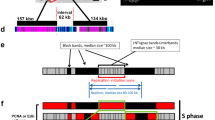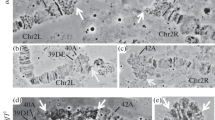Abstract
During the ontogeny of Drosophila larval salivary gland cells, nuclear DNA is endoreduplicated and organized into polytene chromosomes. All DNA sequences are not reduplicated to the same extent. Satellite DNA’s, which are concentrated in the centromeric heterochromatin of diploid cells, are coalesced in the chromocenter of polytene cells (Gall et al. 1971) and selectively underreplicated (Dickson et al. 1971; Gall et al. 1971). In D. virilis, for instance, three satellites comprise about 45% of the diploid DNA (Gall et al. 1971; Blumenfeld and Forrest 1972) but less than 1% of polytene salivary gland cell DNA (Gall et al. 1971). Underreplication presumably involves specific interactions between chromosomal proteins and satellite DNA’s, or nucleotide sequences lying near satellites. Proteins that can be correlated with satellites migth be involved with these interactions. With this in mind, consider that the underreplication of satellite DNA is correlated with the decreased phosphorylation of Hl histones (Blumenfeld et al. 1978).
Access this chapter
Tax calculation will be finalised at checkout
Purchases are for personal use only
Preview
Unable to display preview. Download preview PDF.
Similar content being viewed by others
References
Balhorn R., Chalkley R., Granner D.: Lysine-rich histone phosphorylation: A positive correlation with cell replication. Biochemistry 11, 1094–1098 (1972).
Billings P.C., Orf J.W., Palmer D.K., Talmage D.A., Pan C.G., Blumenfeld M.: Anomalous electrophoretic mobility of Drosophila phosphorylated H1 histone: Is it related to the compaction of satellite DNA into heterochromatin? Nucleic Acids Research 6, 2151–2164 (1979).
Blumenfeld M., Forrest H.S.: Differential underreplication of satellite DNAs during Drosophila development. Nature New Biol. 239, 170–172 (1972).
Blumenfeld M., Orf J.W., Sina B.J., Kreber R.A., Callahan M.A., Mullins J.I., Snyder L.A.: Correlation between phosphorylated H1 histones and satellite DNAs in Drosophila virilis. Proc. Natl. Acad. Sci. USA 75, 866–870 (1978).
Bradbury E.M., Inglis R.J., Matthews H.R., Sarner N.: Phosphorylation of very-lysine-rich histone in Physarum polycephalum. Correlation with chromatin condensation. Eur. J. Biochem. 33, 131–139 (1973).
Dickson E., Boyd J., Laird C.D.: Sequence diversity of polytene chromosome DNA from Drosophila hydei. J. Mol. Biol. 61, 615–627 (1971).
Felsenfeld G.: Chromatin. Nature 271, 115–122 (1978).
Gall J.G., Cohen E.H., Polan M.L.: Repetitive DNA sequences in Drosophila. Chromosoma 33, 319–344 (1971).
Gorovsky M.A., Keevert J.B.: The absence of histone F1 in a mitotically dividing, genetically inactive nucleus. Proc. Natl. Acad. Sci. USA 72, 2672–2676 (1975).
Hohmann P., Tobey R.A., Gurley L.R.: Phosphorylation of distinct regions of F1 histone. Relationship to the cell cycle. J. Biol. Chem. 251, 3685–3692 (1976).
Kornberg R.D.: Structure of chromatin. Ann. Rev. Biochem. 46, 931–954 (1977).
Langan T.A.: Action of adenosine 3′,5′-monophosphate-dependent histone kinase in vivo. J. Biol. Chem. 244, 5763–5765 (1969).
Meisler M.H., Langan T.A.: Characterization of a phosphatase specific for phosphorylated histones and protamine. J. Biol. Chem. 244, 4961–4968 (1969).
Thomas J.O., Kornberg R.D.: An octamer of histones in chromatin and free in solution. Proc. Natl. Acad. Sci. USA 72, 2676–2680 (1975).
Author information
Authors and Affiliations
Editor information
Editors and Affiliations
Rights and permissions
Copyright information
© 1980 Springer-Verlag Berlin Heidelberg
About this chapter
Cite this chapter
Blumenfeld, M., Billings, P.C., Orf, J.W., Pan, C.G., Palmer, D.K., Snyder, L.A. (1980). Differential Histone Phosphorylation During Drosophila Development. In: McKinnell, R.G., DiBerardino, M.A., Blumenfeld, M., Bergad, R.D. (eds) Differentiation and Neoplasia. Results and Problems in Cell Differentiation, vol 11. Springer, Berlin, Heidelberg. https://doi.org/10.1007/978-3-540-38267-6_5
Download citation
DOI: https://doi.org/10.1007/978-3-540-38267-6_5
Publisher Name: Springer, Berlin, Heidelberg
Print ISBN: 978-3-662-11561-9
Online ISBN: 978-3-540-38267-6
eBook Packages: Springer Book Archive




